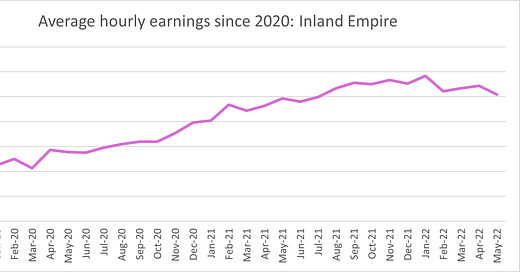Update since Friday: two labor-related stories came out, both about healthcare workers. On Saturday, UC healthcare workers ratified a new contract promising raises of 6%, 5%, and 5% over the next three years (first raise starting January 1, 2023). And the City of Los Angeles enacted a new $25 per hour ordinance for private sector healthcare workers, although some have criticized the law for not covering public sector healthcare workers – read more at the link.
On Friday, I had an excellent discussion with KVCR’s Jonathan Linden about the region’s low unemployment rate, and what it all means for the economy as we move into the second half of 2022. You can check out the interview here.
One of the topics we touched on is whether regional workers are seeing boosts in their pay to go along with the increase in job opportunities. This has been a common theme in this newsletter: we know that the logistics industry is driving the excellent job growth we’ve seen in the region over the last two years, but that industry does not pay well. Over the last six months or so, average wages have actually been declining in the region. See the chart below.
While wages are still up about 12% since the start of 2020, they were even higher at the start of 2022. And no, this is not normal – even though the labor market has, at this point, “soaked up” most of the productive workers, the historically low unemployment rate should be pushing up the offers companies make to workers, not pushing them down. This is even more true with the excessive rates of inflation we’ve seen over the last year.
There is more direct evidence of low pay in logistics. According to Occupational Employment and Wage Statistics, as of mid-2021, the median wage of all workers in the Inland Empire was $18.76. That means 50% of the region’s workers make above that, and 50% below. See here for the source.
In “transportation and material moving”, which is the region’s top set of occupations by total employment, the median was only $18.22. In fact, out of the top 5 occupational sets, only office and administrative support’s median wage is higher than the region overall. Ideally, the region should attract more jobs in healthcare, education, and management positions if it wants better wage growth statistics.
The top 10 occupations by % total employment are presented here – source at the link above.
Job growth is good news, but sustainable growth calls for higher incomes as well.




